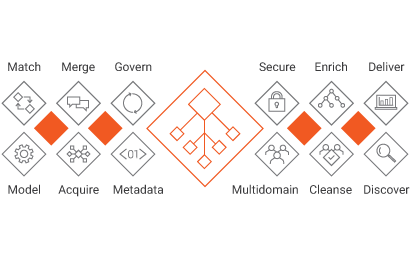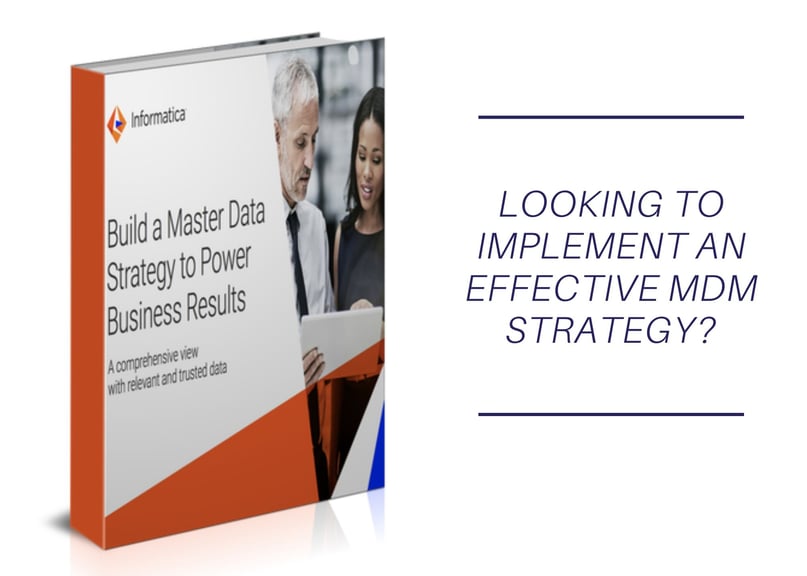
By now, business has acknowledged that mastered data can truly be a game-changer for an enterprise. Trusted data insights fuel confident business decisions, improve the quality of information, drive operational efficiency, help make faster business decisions, and improve the end-to-end business processes—all of which contribute to company growth. The bottom line is, better business outcomes come from better data.
Master Data Management (MDM) acts as a true end-to-end solution encompassing the data quality, data integration, business process management, and data security that an organization needs in order to master their data. Let’s look at a few core capabilities of MDM in more detail, and see how MDM can be the one-stop solution for all your organization’s data needs.
MDM Capabilities

Discover: The MDM implementation process allows organizations to discover and understand data that is spread across different silos, domains, and systems. This lays a proper roadmap for the MDM journey ahead. The discovery phase magnifies data challenges that may arise due to data quality issues and identifies milestones that will need to be completed along the MDM journey.
Model: An effective Master Data Management system calls for a robust design that incorporates business-critical data elements. The goal is for the MDM model to fit seamlessly into the existing IT ecosystem of the organization. This step is vital as the MDM model will be the ‘cornerstone’ of the entire MDM implementation.
Cleanse: With MDM, a company can cleanse, standardize, and correct data coming from disparate source systems to prepare the data for mastering. This is a critical milestone in the MDM journey as cleansed data yields high quality, trustable master data. Address standardization is an example of a process that utilizes MDM cleansing.
Enrich: Companies can enrich and enhance the quality and quantity of their information data with MDM. For example, external sources such as D&B, LexisNexis, and credit bureaus can be used to enrich existing data. Such sources can significantly contribute to master data.
Recognize (includes Matching): MDM can identify correct parameters such as population (domestic and international), match purpose, geography, etc. based on matching performed. MDM also uses these parameters to great effect while applying deterministic-Exact & probabilistic-Fuzzy matching logic to identify duplicates in the data.
Resolve (includes Merge and Unmerge): MDM consolidates data using a trust framework. A trust framework has trust scores for source systems, with higher scores indicating the most trusted systems and lower scores indicating lesser trusted systems. MDM uses trust frameworks and survivorship rules to validate merge clusters and produce a golden record of data. MDM also lets users unmerge records/clusters if the records are found to incorrectly consolidated.
Relate: MDM efficiently links related master records both within MDM and from other domains to build hierarchies and taxonomies such as Party-Product, Product-Supplier, Supplier-Location, Party-Location, etc.
Govern: MDM provides an interactive and informatic graphical user interface (GUI) for data governance, data monitoring, data management, data stewardship, and executing BPM workflows. This GUI provides a 360-degree view of the mastered attributes.
Access: MDM provides seamless access to its master data via both batch and real-time modes. MDM can make master data available to all source systems that provided their data to MDM for mastering, in order to synchronize their data and applications with the newly created or updated master data. MDM also can efficiently integrate with enterprise-wide systems such as ERP and ESB.
Deliver: Once MDM is live and validated, users can extract reports for stakeholders, enhance master data, and eventually transform MDM to a federated and foundational data source where a single version of the truth for all data resides.
Value Adds of MDM

Achieve Outstanding Customer Satisfaction and Deliver Exceptional Customer Experiences
MDM creates a reliable and complete 360-degree view of customers. This empowers organizations to provide personalization as well as customer-centric products and services. This elevated level of personalization keeps customers happy and is essential to building long-lasting relationships.
Improve Data Quality
MDM is a one-stop solution to cleanse, enrich, consolidate, master, and govern data across the enterprise. The marked improvement that Master Data Management brings to the health of a company’s data is striking.
Lower Operating Costs
MDM fuels marketing and sales strategies by giving enterprises a precise data foundation for customer segmentation. This helps organizations channel their time and money into the right avenues, reducing unnecessary spend, and improving ROI.
Competitive Edge
MDM improves efficiency throughout the entire product chain (and supply chain). With this, companies can more efficiently onboard, cleanse, and enrich every aspect of product information while sharing, publishing, and syndicating it across all critical enterprise channels. This allows companies to launch new products faster, thereby gaining a crucial edge over their competitors in the market.
Regulation and Compliance
MDM helps organizations become compliant with various mandates, including the General Data Protection Regulation (GDPR) and the California Consumer Protection Act (CCPA). When data is mastered, audits become a simple task rather than an arduous trial.
Streamline Mergers and Acquisitions
MDM can assist in the design of a perfect strategy for Mergers and Acquisitions by identifying commonalities between organizations. With a holistic view of business-critical data elements, M&As can be handled smoothly, reducing the risk to the parties involved.
Reduced Dependency on External Sources
Dependency on external sources such as D&B, LexisNexis, and credit bureaus can be reduced significantly with MDM, lowering subscription costs. This is possible when MDM is able to sources these values across the enterprise.

- Enable end-users to perform hierarchy analysis from a timeline view, to make audit changes, and to perform bulk updates.
- Allow end-users to drag and drop hierarchy elements, making the system usable for individuals with little technical knowledge.
- Display two hierarchy views on a single screen without having to access multiple systems.
- Create, update, delete, or display data on an interactable GUI.
- Users have the option to add new hierarchy elements via user inputs and batch loads from source systems. Users may also publish real-time MDM data to enterprise applications using a service layer (Service Integration Framework & Business Entity Services) and messaging queues.
- The Supplier Gateway Platform now serves as a hub, storing supplier records from the MDM system and external systems for matching. This hub is able to perform fuzzy matching based on unique business attributes, thereby eliminating duplications.
- The time it takes to on-board M&A suppliers was reduced by over 90%. The first M&A completed after the launch of PDI’s supplier gateway took 3 weeks, compared to the estimated 12 months it would have taken before this project.
- Dependency on DUNS numbers was significantly reduced, thereby lowering subscription costs.
- Reusable Informatica components ensure traceability as per the company’s iPaaS standards and complies with audit and governance regulations.
- Users can differentiate data based on its business purpose, with separate templates for each purpose.
- IDD enables users to correct or drop records if they are identified as incomplete or incorrect. End users are able to focus on data preparation and quality, without spending effort on data upload completeness.
- The data upload framework is completely integrated between the MDM system and iPaaS layer, thus automating the file upload.


Posted by PDI Marketing Team
Pacific Data Integrators Offers Unique Data Solutions Leveraging AI/ML, Large Language Models (Open AI: GPT-4, Meta: Llama2, Databricks: Dolly), Cloud, Data Management and Analytics Technologies, Helping Leading Organizations Solve Their Critical Business Challenges, Drive Data Driven Insights, Improve Decision-Making, and Achieve Business Objectives.




